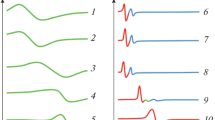Abstract
Thin-film Mo–SiO2 + C–Al systems are investigated. It is demonstrated that the electrical properties of these systems depend strongly on the percentage of carbon in a composite Si + C target at the stage of preparing the dielectric. The results obtained are interpreted in the context of the chemical interaction of carbon with silicon dioxide.
Similar content being viewed by others
REFERENCES
G. A. Vorob'ev and V. M. Gaponenko, Izv. Vyssh. Uchebn. Zaved., Fiz., No. 1, 65–67 (1991).
V. M. Gaponenko, Izv. Vyssh. Uchebn. Zaved., Fiz., No. 5, 115–120 (1992).
P. E. Troyan, Izv. Vyssh. Uchebn. Zaved., Fiz., No. 6, 55–60 (1996).
Author information
Authors and Affiliations
Rights and permissions
About this article
Cite this article
Troyan, P.E., Zhigal'skii, A.A. & Sakharov, Y.V. Role of Carbon in the Electric Forming of Metal–Dielectric–Metal Systems. Russian Physics Journal 46, 145–148 (2003). https://doi.org/10.1023/A:1024637811468
Issue Date:
DOI: https://doi.org/10.1023/A:1024637811468




